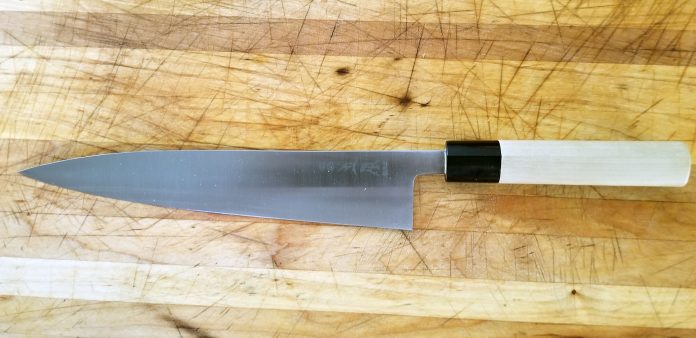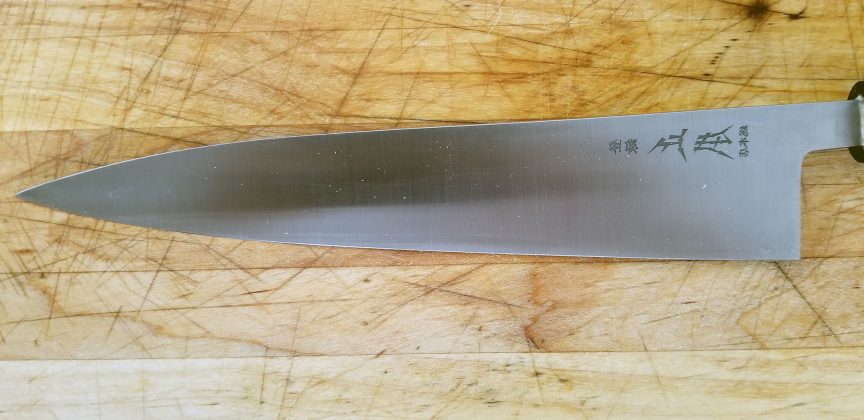Here’s another knife review on the Masamoto KS Honkasumi Gyokuhaku-ko Buffalo Tsuba Japanese Chef’s Gyuto Knife. I’ve been writing more about knives because I think that we should be using our best knives now and not keep them on display for a special day. Right now, your best knife is probably locked up in a box just waiting to be used. Today, I’m going to go over the Masamoto KS Honkasumi Gyokuhaku-ko Buffalo Tsuba Japanese Chef’s Gyuto Knife. Wow! That was a mouthful. Even more wow is the cutting ability of this knife.
Masamoto knives have been around for more than 160 years. They are also known as the number 1 sushi chef knife maker in Japan…or at least in Tokyo.
The Masamoto “KS” Hon-Kasumi Gyokuhaku-ko made from White Steel. The White Steel in the KS edition starts with a traditional TAMA-HAGANE which is made with the much-treasured secret the materials of the iron selected carefully from Masago iron sand of the historical San-in district in Japan. It is then forged welded with soft iron. This gives it a strong knife with a razor-sharp center.
I really enjoyed taking this knife out of the package and testing it right away. The hand sharpening and finishing process was amazing when compared to machine sharpened knives.
The handle has a Buffalo Tsuba (the guard) is a great addition. I think my other Japanese knives have a plastic tsuba.
There are a few sizes to choose from:
- 240mm (9.4in.)
- 270mm (10.6in.)
- 300mm (11.8in.)
- 330mm (13.0in.)
I needed something to fit into my roll so I went with the 240mm. The longer knives feel awkward to use. If anything, I think I would have purchased a 270mm…maybe 300mm. I have a 300mm knife…yanagiba. It is a lot of blade to work with in a small environment. And I’m also used to carrying around my Global G2 8″ Chef Knife so really that 240mm is right up my alley. The weight is about 160g (about 1/3 of a pound).
I’m so afraid of this knife. Not because of the sharpness but more of the fear of ruining a good knife because of lack of maintenance and care in cleaning. I have a super high carbon santoku laying around with giant rust spots on it. Here are my steps so far:
- Wash it immediately after use.
- Dry it.
- Find stuff I didn’t clean from step 1 and wash it again.
- Dry it again.
- Dry it more.
- Add a drop of oil and rub it all over the knife and store in a dry location.
This procedure works and I’ll probably stick with it. I’d say to follow the instructions after sharpening too. But if you’re sharpening your own, then you’ll understand how to clean the knife to last longer.
Overall, this is a wonderful knife that I enjoy using. I do have to fight the urge to reach for my Global G2.








[…] Masamoto KS Honkasumi Gyokuhaku-ko Buffalo Tsuba Japanese Chef’s Gyuto Knife […]